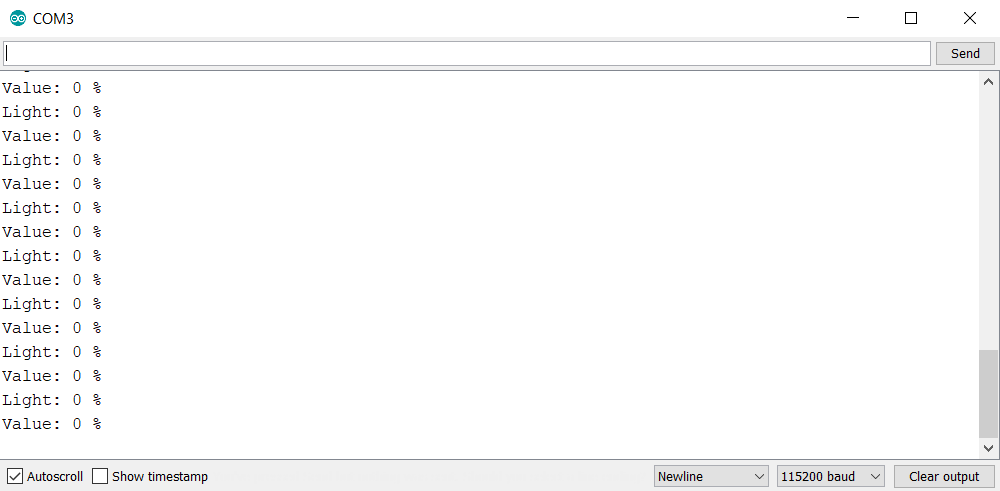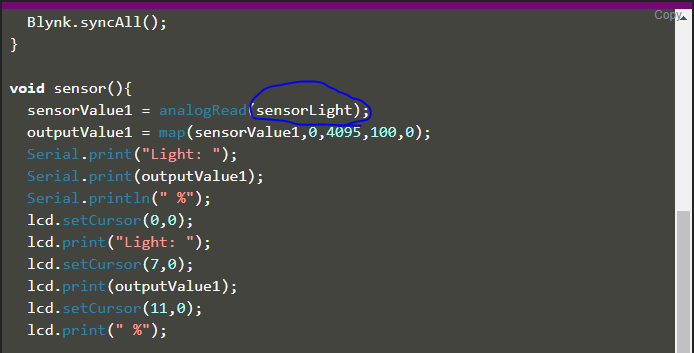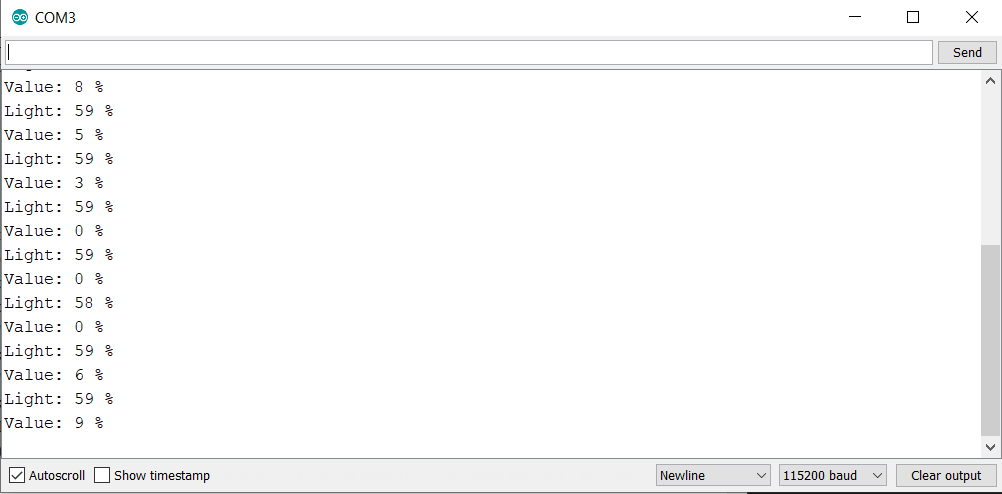ผมใช้บอร์ด ESP32
ตอนที่เขียนโค๊ดแบบไม่ได้เชื่อมต่อ BLYNK แสดงค่าปกติ
ตอนเชื่อมต่อ BLYNK ค่าแสดงเป็น0ตลอดเวลาไม่เปลี่ยนแปลง
#include <Wire.h>
#include <LiquidCrystal_I2C.h>
LiquidCrystal_I2C lcd(0x3F, 16, 2);
#define BLYNK_PRINT Serial
#include <WiFi.h>
#include <WiFiClient.h>
#include <BlynkSimpleEsp32.h>
int RelayLight=12;
int RelayValue=13;
int sensorLight=2;
int sensorValue=4;
int sensorValue1 = 0; // ตัวแปรค่า Analog
int outputValue1 = 0; // ตัวแปรสำหรับ Map เพื่อคิด %
int sensorValue2 = 0; // ตัวแปรค่า Analog
int outputValue2 = 0; // ตัวแปรสำหรับ Map เพื่อคิด %
char auth[] = "L5xSTLXHIkZDiG_bWK8JqeWinn_G76xG";
char ssid[] = "CHALOR@1B";
char pass[] = "0862136574";
char server[] = "oasiskit.com";
int port = 8080;
BlynkTimer timer;
BLYNK_CONNECTED(){
Blynk.syncAll();
}
void sensor(){
sensorValue1 = analogRead(sensorLight);
outputValue1 = map(sensorValue1,0,4095,100,0);
Serial.print("Light: ");
Serial.print(outputValue1);
Serial.println(" %");
lcd.setCursor(0,0);
lcd.print("Light: ");
lcd.setCursor(7,0);
lcd.print(outputValue1);
lcd.setCursor(11,0);
lcd.print(" %");
sensorValue2=analogRead(sensorValue);
outputValue2 =map(sensorValue2,0,4095,0,100);
Serial.print("Value: ");
Serial.print(outputValue2);
Serial.println(" %");
lcd.setCursor(0,1);
lcd.print("Value: ");
lcd.setCursor(7,1);
lcd.print(outputValue2 );
lcd.setCursor(11,1);
lcd.print(" %");
delay(1000);
}
void setup() {
Serial.begin(115200);
pinMode(RelayLight,OUTPUT);
pinMode(RelayValue,OUTPUT);
Blynk.begin(auth, ssid, pass, server, port);
timer.setInterval(500,sensor);
}
void loop() {
Blynk.run();
timer.run();
}
Remy_Martin
(Permpol Thanapunnamas)
2
ค่าเป็น 0 ที่ไหนครับ ที่บอร์ด หรือว่าที่ app
Serial Monitor จอLCD แอพด้วยครับ
Remy_Martin
(Permpol Thanapunnamas)
5
แคบตรง serial มาดูหน่อยครับ
Remy_Martin
(Permpol Thanapunnamas)
6
ค่าตรงนี้ได้เท่าไหร่ก่อนแปลง
ค่าตรงนี้คือการอ่านค่า จากขา GPIOขา2 โดยตรงครับ
Remy_Martin
(Permpol Thanapunnamas)
8
ใช่ครับ อยากรู้ว่ามันได้เท่าไหร่ ก่อนที่จะถูกแปลงออกมาเป็น 0
ตัวโปรแกรมแบบไม่เชื่อมต่อกับ Blynk ใช้งานได้ปกติ
#include <Wire.h>
#include <LiquidCrystal_I2C.h>
LiquidCrystal_I2C lcd(0x3F, 16, 2);
int sensorLight=2;
int sensorValue=4;
int sensorValue1 = 0; // ตัวแปรค่า Analog
int outputValue1 = 0; // ตัวแปรสำหรับ Map เพื่อคิด %
int sensorValue2 = 0; // ตัวแปรค่า Analog
int outputValue2 = 0; // ตัวแปรสำหรับ Map เพื่อคิด %
โค๊ดโปรแกรมแบบไม่เชื่อมต่อ Blynk
void setup() {
Serial.begin(115200); // set up serial port for 9600 baud (speed)
delay(500); // wait for display to boot up
lcd.begin();
lcd.backlight();
}
void loop() {
sensorValue1 = analogRead(sensorLight);
outputValue1 = map(sensorValue1,0,4095,100,0);
Serial.print("Light: ");
Serial.print(outputValue1);
Serial.println(" %");
lcd.setCursor(0,0);
lcd.print("Light: ");
lcd.setCursor(7,0);
lcd.print(outputValue1);
lcd.setCursor(11,0);
lcd.print(" %");
sensorValue2=analogRead(sensorValue);
outputValue2 =map(sensorValue2,0,4095,100,0);
Serial.print("Value: ");
Serial.print(outputValue2);
Serial.println(" %");
lcd.setCursor(0,1);
lcd.print("Value: ");
lcd.setCursor(7,1);
lcd.print(outputValue2 );
lcd.setCursor(11,1);
lcd.print(" %");
delay(1000);
}
1 Likes
ค่าAnalogที่รับ esp32 อยู่ที่0-4095 ครับ
Remy_Martin
(Permpol Thanapunnamas)
11
ลองเพิ่มการกำหนด port ดูครับว่าได้ไหม
pinMode(sensorLight,INPUT); //กำหนด port ให้เป็น input
pinMode(sensorValue,INPUT); //กำหนด port ให้เป็น input
#include <Wire.h>
#include <LiquidCrystal_I2C.h>
LiquidCrystal_I2C lcd(0x3F, 16, 2);
#define BLYNK_PRINT Serial
#include <WiFi.h>
#include <WiFiClient.h>
#include <BlynkSimpleEsp32.h>
int RelayLight=12;
int RelayValue=13;
int sensorLight=2;
int sensorValue=4;
int sensorValue1 = 0; // ตัวแปรค่า Analog
int outputValue1 = 0; // ตัวแปรสำหรับ Map เพื่อคิด %
int sensorValue2 = 0; // ตัวแปรค่า Analog
int outputValue2 = 0; // ตัวแปรสำหรับ Map เพื่อคิด %
char auth[] = "L5xSTLXHIkZDiG_bWK8JqeWinn_G76xG";
char ssid[] = "CHALOR@1B";
char pass[] = "0862136574";
char server[] = "oasiskit.com";
int port = 8080;
BlynkTimer timer;
BLYNK_CONNECTED(){
Blynk.syncAll();
}
void sensor(){
sensorValue1 = analogRead(sensorLight);
outputValue1 = map(sensorValue1,0,4095,100,0);
Serial.print("Light: ");
Serial.print(outputValue1);
Serial.println(" %");
lcd.setCursor(0,0);
lcd.print("Light: ");
lcd.setCursor(7,0);
lcd.print(outputValue1);
lcd.setCursor(11,0);
lcd.print(" %");
sensorValue2=analogRead(sensorValue);
outputValue2 =map(sensorValue2,0,4095,0,100);
Serial.print("Value: ");
Serial.print(outputValue2);
Serial.println(" %");
lcd.setCursor(0,1);
lcd.print("Value: ");
lcd.setCursor(7,1);
lcd.print(outputValue2 );
lcd.setCursor(11,1);
lcd.print(" %");
delay(1000);
}
void setup() {
Serial.begin(115200);
pinMode(RelayLight,OUTPUT);
pinMode(RelayValue,OUTPUT);
pinMode(sensorLight,INPUT); //กำหนด port ให้เป็น input
pinMode(sensorValue,INPUT); //กำหนด port ให้เป็น input
Blynk.begin(auth, ssid, pass, server, port);
timer.setInterval(500,sensor);
}
void loop() {
Blynk.run();
timer.run();
}
1 Likes
Remy_Martin
(Permpol Thanapunnamas)
13
ดูโค้ตที่ผมแก้ให้ไปอะครับ
1 Likes
ลองแล้วครับ ขึ้นเหมือนเดิมครับ
Remy_Martin
(Permpol Thanapunnamas)
15
อันนี้คือแค่เปลี่ยนโค้ตเป็นอันเก่าก็อ่านได้เลยใช่ป่ะครับ
แค่ตัดส่วนของ blynk ออกทั้งหมดก็ใช้งานได้ปกติครับ
Remy_Martin
(Permpol Thanapunnamas)
17
ใช้เซ็นเซอร์ตัวไหนถ่านมาดูหน่อยครับ
1 Likes
Remy_Martin
(Permpol Thanapunnamas)
19
ลองย้ายชุดนี้กลับไปที่ void loop() ดูว่าได้ผลอย่างไร
sensorValue1 = analogRead(sensorLight);
outputValue1 = map(sensorValue1,0,4095,100,0);
Serial.print("Light: ");
Serial.print(outputValue1);
Serial.println(" %");
lcd.setCursor(0,0);
lcd.print("Light: ");
lcd.setCursor(7,0);
lcd.print(outputValue1);
lcd.setCursor(11,0);
lcd.print(" %");
sensorValue2=analogRead(sensorValue);
outputValue2 =map(sensorValue2,0,4095,0,100);
Serial.print("Value: ");
Serial.print(outputValue2);
Serial.println(" %");
lcd.setCursor(0,1);
lcd.print("Value: ");
lcd.setCursor(7,1);
lcd.print(outputValue2 );
lcd.setCursor(11,1);
lcd.print(" %");
delay(1000);
ลองแล้วครับ ขึ้น0เหมือนเดิม
#include <Wire.h>
#include <LiquidCrystal_I2C.h>
LiquidCrystal_I2C lcd(0x3F, 16, 2);
#define BLYNK_PRINT Serial
#include <WiFi.h>
#include <WiFiClient.h>
#include <BlynkSimpleEsp32.h>
int RelayLight=12;
int RelayValue=13;
int sensorLight=2;
int sensorValue=4;
int sensorValue1 = 0; // ตัวแปรค่า Analog
int outputValue1 = 0; // ตัวแปรสำหรับ Map เพื่อคิด %
int sensorValue2 = 0; // ตัวแปรค่า Analog
int outputValue2 = 0; // ตัวแปรสำหรับ Map เพื่อคิด %
char auth[] = "L5xSTLXHIkZDiG_bWK8JqeWinn_G76xG";
char ssid[] = "CHALOR@1B";
char pass[] = "0862136574";
char server[] = "oasiskit.com";
int port = 8080;
void setup() {
Serial.begin(115200);
pinMode(RelayLight,OUTPUT);
pinMode(RelayValue,OUTPUT);
pinMode(sensorLight,INPUT);
pinMode(sensorValue,INPUT);
Blynk.begin(auth, ssid, pass, server, port);
}
void loop() {
sensorValue1 = analogRead(sensorLight);
outputValue1 = map(sensorValue1,0,4095,100,0);
Serial.print("Light: ");
Serial.print(outputValue1);
Serial.println(" %");
lcd.setCursor(0,0);
lcd.print("Light: ");
lcd.setCursor(7,0);
lcd.print(outputValue1);
lcd.setCursor(11,0);
lcd.print(" %");
sensorValue2=analogRead(sensorValue);
outputValue2 =map(sensorValue2,0,4095,100,0);
Serial.print("Value: ");
Serial.print(outputValue2);
Serial.println(" %");
lcd.setCursor(0,1);
lcd.print("Value: ");
lcd.setCursor(7,1);
lcd.print(outputValue2 );
lcd.setCursor(11,1);
lcd.print(" %");
delay(1000);
Blynk.run();
}



